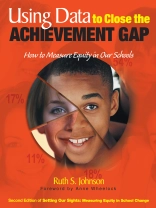‘Dr. Johnson′s work provides both the philosophical and practical blueprint for transforming public schools into the learning communities we want and need. Leaders will find the book to be the most useful document to guide and inform their efforts to close the gap and maximize learning for all students.’
Joseph Burke , Superintendent of Schools
Springfield Public Schools
Springfield, MA
‘If the goal of all students reaching high standards is to be met, Using Data to Close the Achievement Gap should be required reading for all teachers and administrators. It should also be an integral part of the course of study for those preparing to teach in the United States.’
Vinetta C. Jones , Dean
School of Education, Howard University
‘From Johnson′s penetrating analysis of current research, policies, and practices, and her wealth of experiences working with school districts around the nation, she clearly makes the connection between using data and achieving equitable outcomes as districts and schools struggle to close the achievement gap.’
Aukram Burton , Diversity/Multicultural Specialist
Gheen Professional Development Academy
Louisville, KY
‘This book represents a significant contribution to the national debate around school reform. Ruth Johnson presents a thoughtful, well-documented treatise on how educators, policymakers, and parents can use data to set achievement goals and to measure progress towards these goals.’
Walter Allen , Professor
Department of Sociology, UCLA
Exercise the power of data to identify and rectify educational inequalities!
Student populations are diverse—however, their access to knowledge and success should not be. Unfortunately, statistics show that real disparities do exist in academic achievement, which consistently coincide with income level and race. In this comprehensive guide, Ruth S. Johnson highlights compelling evidence that these inequities can be linked to school practices that inadvertently increase inequities. The solution to this pervasive problem lies in the collection and examination of appropriate data, and this book shows readers how.
This updated edition of Setting Our Sights: Measuring Equity in School Change now includes current studies, policies, and practices, and provides new sections on data dialogues and school indicators. It offers valuable assistance for understanding, visioning, planning, and executing tactics that can successfully close the gap in student achievement, including:
- Straightforward and in-depth discussions of the five stages for equity reform
- Clear and easy-to-understand explanations of research findings
- Practical tools including questionnaires, surveys, forms, and models
- Tips for effectively gathering, analyzing, and applying data
Johnson shows how data is instrumental not only in targeting areas for improvement, but also in offering insights into the necessary steps to foster positive change and create a culture of high achievement for all students, especially those students who have traditionally been overlooked. An indispensable reference for any school undergoing a quality review process, this reader-friendly manual presents practical how-to′s for analyzing data and developing a strategy that empowers teachers and administrators with an equal opportunity for success.
Содержание
Foreword: A Strategy to Challenge Inequality — Anne Wheelock
Introduction: New to the Second Edition
Acknowledgments
About the Author
Part I: Setting Our Sights on Student Achievement
1. The Achievement Gap: Framing Our Minds to Set Our Sights
The Achievement Gap
Some Other Considerations
Rethinking the Issues: Creating the Conditions for Moving Forward
Stages in the Change Process: How Data Offer Help and Hope
2. Building Dissatisfaction and Killing the Myths: Examining Data as a First Step Toward Motivating Reform
The Broader Picture: Societal Implications of Undereducating Certain Populations
Similar Aspirations, Unequal Chances: Data to Dispel Myths and Demonstrate Differential Expectations and Learning Opportunities for Students
Who Has the Opportunity to Go to College?
Changing Practices and Achievement Patterns: Exploding Myths That Perpetuate Underachievement
3. Data in the Reform Process: How and Why
Key Roles for Data
Assessing Data Use and Access
Stages of the Data User Process
Using Technology to Make Strong Presentations
4. Building Leadership and Data Teams
Establishing the Need: A First Step for Highly Resistant Schools
Creating the Team: The First Step in Most Schools
The Role of the Leadership Team
Structuring the Leadership Team′s Work
Team Development
The Data Team: Core to the The Data Team: Core to the School′s Success in Using Data to Achieve Reform
Planning for Team Success: Team Self-Assessment of Strengths and Needs
Assessing Perspectives of Team Effectiveness
Planning for Team Leadership Development
Part II: Inquiring About Equity
5. Talking About Data
Why the Need for Dialogue
Guiding the Dialogue
Outcomes From Dialogues
Conducting the Inquiry: Measurement Dimensions and Approaches
6. Examining Outcomes
Looking at the Big Picture
Outcome Data From Standardized Test Scores: Peeling the Data
Standardized Tests for College Going
Monitoring Student Grades
Displaying Middle and High School Course Enrollment and Student Overall Progress in College Preparatory Courses
Outcomes: Student Graduation Rates
College-Going Rates
Nonacademic Measures Related to Outcomes
7. Assessing Policies and Practices
Part I: Instruments
Assessing Perceptions of Attitudes, Readiness, and Commitment to Reform at the School
Process Indicators
Assessing Institutional Reform in the Academic Culture of Schools
Other Instruments to Assess Equity
Schools′ and Districts′ Assessments of Delivery of Precollege Guidance
Characteristics of High-Performing and Low-Performing Counseling Programs
Counselor College Preparatory Record Keeping for Individual Students
Which Counselors Are Providing College Access to Students?
Counselor′s Plans for Counselees
Part II: Existing School Documents
How Does the Master Schedule Reflect Practices and Goals?
Assessing Documents, Policies, and Practices on How Time Is Used
Examining School Calendars
Teacher Plan Books
Part III: Assessing Equitable Classroom Practices
Survey—The Equitable School Classroom
Teacher Observations
Observing Students in Class and School
Parent and Student Information
8. Listening to Student and Parent Voices
Student and Parent-Guardian Questionnaires
Aspirations and Reality
Listening to Students′ Voices Regarding the Academic Culture of the School
9. Evaluating Programs and Interventions
Analyses of Efforts to Raise Student Achievement
Assessing Elementary Programs and Practices
Assessing the Improvement of College Preparation and College-Going Rates
Professional Development
10. Using School Indicators to Answer Critical Questions
How and When to Gather Indicators
Combining Indicators to Answer Critical Questions
Sample Indicator Combinations
11. Will We Know It When We See It? Visioning, Planning, and Implementation
Planning for Monitoring
Plan for Monitoring the Improvement of College Preparation and College-Going Rates
The Role of the External Resource Person
Resources for Equitable School Reform
Bibliography
References
Index
Об авторе
Ruth S. Johnson is a professor emeritus at California State University, Los Angeles. She has served in a variety of educational settings in New Jersey and California. Ruth received her Ed.D. in 1985 from Rutgers, The State University of New Jersey. Her dissertation was titled An Exploratory Study of Academic Labeling, Student Achievement and Student Ethnographic Characteristics. At the K–12 level, she served as a classroom teacher, an instructional consultant, a director of elementary education, an analyst, an assistant superintendent of schools in the areas of curriculum and business, and as a superintendent of schools. She initiated efforts that resulted in raising academic standards and student achievement in low performing school districts. She served as an education consultant for the New Jersey Department of Education and as a director for two non-profit organizations in California which focused on raising student achievement in underserved student populations. Her major scholarly interests and publications focus on processes related to changing the academic culture of urban schools, with an emphasis on access and equity. In addition to her four published books, she has written numerous book chapters, articles, editorials, research reports, and manuscript reviews. As a recognized speaker, she has presented nationally to scholarly and professional audiences and serves as a consultant to schools and districts.












